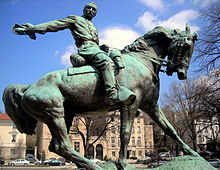Sheridan Circle

Sheridan Circle is a traffic circle in the Washington, D.C. neighborhood of Embassy Row.
A number of embassies ring Sheridan Circle, including the former Turkish chancery, and the Romanian embassy on the southern side, and the Embassy of Pakistan to the northwest.
Dupont Circle is visible down Massachusetts Avenue; in the other direction, the avenue rises toward a bridge over Rock Creek Park.
History[]
In 1888,[1] the traffic circle was named for General Philip Sheridan, Union general of the American Civil War and later general of the United States Army.
Sheridan Monument[]
A statue to honor General Sheridan was originally proposed to stand on the north side of Pennsylvania Avenue NW near 13th Street NW,[2] at what is now Freedom Plaza. Gen. Sheridan's widow advocated to erect the statue at Sheridan Circle instead,[2] with which the statue commission agreed.[3] John Quincy Adams Ward was selected to sculpt the statue.[4] Mrs. Sheridan rejected his original model, saying it was not a good likeness of Gen. Sheridan,[4] and the statue commission rejected Ward's model.[5] The commission and Mrs. Sheridan both approved of a model created by Gutzon Borglum.[6] The statue was dedicated on November 27, 1908.[7]
Letelier Monument[]

On September 21, 1976, Orlando Letelier and Ronni Karpen Moffitt were killed by a car bomb in the circle. Letelier had been foreign minister in the ousted Allende government of Chile. The bombing was blamed on Chilean DINA agents. Michael Townley, a DINA U.S. expatriate among those convicted for the crime, confessed that he had hired five anti-Castro Cuban exiles to booby-trap Letelier's car. According to Jean-Guy Allard, after consultations with the Coordination of United Revolutionary Organizations leadership (including Luis Posada Carriles and Orlando Bosch), those selected to carry out the murder were Cuban-Americans José Dionisio Suárez, Virgilio Paz Romero, Alvin Ross Díaz and brothers Guillermo and Ignacio Novo Sampoll.[8] According to the Miami Herald, Luis Posada Carriles was at the meeting that decided on Letelier's death and also about the Cubana bombing two weeks later.
Letelier and Moffitt are commemorated with a small plaque embedded in the grass along the curb where they died, near the Irish and Romanian embassies.
Clashes[]
On May 16, 2017, dozens of PKK supporters and Kurdish separatists clashed with Turkish security officials at Sheridan Circle. Turkish President Recep Tayyip Erdoğan, visiting the Ambassador's residence that sits on Sheridan Circle, watched the clashes from a distance. [9]
See also[]
References[]
- ^ "District Government Affairs: In Honor of Gen. Sheridan". Washington Evening Star. October 24, 1888. p. 5.
- ^ a b "Site for Sheridan Statue". Washington Evening Star. June 3, 1903. p. 2.
- ^ "Commissions Meet". Washington Evening Star. June 17, 1903. p. 1.
- ^ a b "Board of Artists Named". Washington Evening Star. September 22, 1906. p. 2.
- ^ "Reject Statue Model: Action of Commission Having Sheridan Memorial in Charge". Washington Evening Star. March 13, 1907. p. 6.
- ^ "Statue of Phil Sheridan: Commission Today Accepts Model by Gutzon Borglum". Washington Evening Star. January 17, 1908. p. 1.
- ^ "Unveiling Preparations Good: Sheridan Statue Ceremonies Well Conducted". Washington Evening Star. November 27, 1908. p. 12.
- ^ [1] Archived June 12, 2006, at the Wayback Machine
- ^ "Raw: Video shows Erdogan observing clashes in DC". USA Today. May 18, 2017. Retrieved May 22, 2017.
External links[]
| Wikimedia Commons has media related to Sheridan Circle. |
- Sheridan-Kalorama ANC
- Ghost Dog Has Three Stories From Sheridan Circle - three historical stories about Sheridan Circle
Coordinates: 38°54′43″N 77°03′02″W / 38.91194°N 77.05056°W
- Squares, plazas, and circles in Washington, D.C.
- Streets in Washington, D.C.
- Embassy Row
